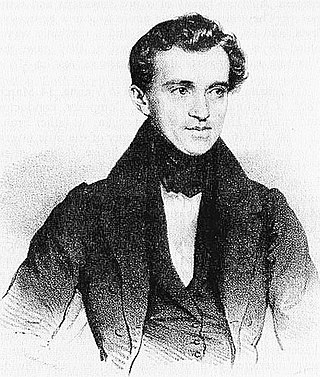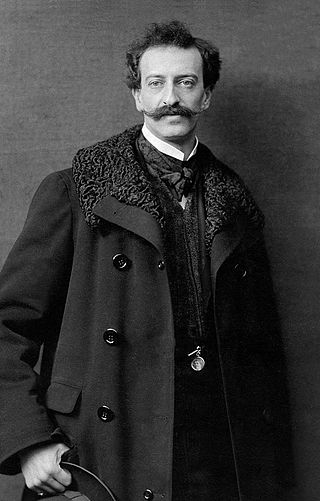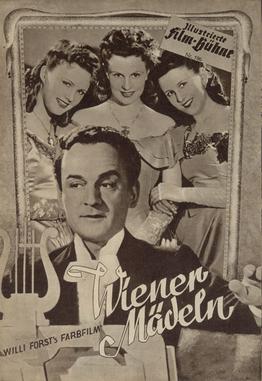
Johann Baptist Strauss II, also known as Johann Strauss Jr., the Younger or the Son, was an Austrian composer of light music, particularly dance music and operettas as well as a violinist. He composed over 500 waltzes, polkas, quadrilles, and other types of dance music, as well as several operettas and a ballet. In his lifetime, he was known as "The Waltz King", and was largely responsible for the popularity of the waltz in the 19th century. Some of Johann Strauss's most famous works include "The Blue Danube", "Kaiser-Walzer", "Tales from the Vienna Woods", "Frühlingsstimmen", and the "Tritsch-Tratsch-Polka". Among his operettas, Die Fledermaus and Der Zigeunerbaron are the best known.

Johann Baptist Strauss I, also known as Johann Strauss Sr., the Elder or the Father, was an Austrian composer of the Romantic Period. He was famous for his light music, namely waltzes, polkas, and galops, which he popularized alongside Joseph Lanner, thereby setting the foundations for his sons—Johann, Josef and Eduard—to carry on his musical dynasty. He is best known for his composition of the Radetzky March.

The Vienna New Year's Concert is an annual concert of classical music performed by the Vienna Philharmonic on the morning of New Year's Day in Vienna, Austria. The concert occurs at the Musikverein at 11:15. The orchestra performs the same concert programme on 30 December, 31 December, and 1 January but only the last concert is every year broadcast on radio and television.

Josef Strauss was an Austrian composer.

Oscar Nathan Straus was a Viennese composer of operettas, film scores, and songs. He also wrote about 500 cabaret songs, chamber music, and orchestral and choral works. His original name was actually Strauss, but for professional purposes he deliberately omitted the final 's'. He wished not to be associated with the musical Strauss family of Vienna. However, he did follow the advice of Johann Strauss II in 1898 about abandoning the prospective lure of writing waltzes for the more lucrative business of writing for the theatre.

"The Blue Danube" is the common English title of "An der schönen blauen Donau", Op. 314, a waltz by the Austrian composer Johann Strauss II, composed in 1866. Originally performed on 15 February 1867 at a concert of the Wiener Männergesang-Verein, it has been one of the most consistently popular pieces of music in the classical repertoire. Its initial performance was considered only a mild success, however, and Strauss is reputed to have said, "The devil take the waltz, my only regret is for the coda—I wish that had been a success!"

Carl Michael Ziehrer was an Austrian composer. In his lifetime, he was one of the fiercest rivals of the Strauss family; most notably Johann Strauss II and Eduard Strauss.
Liebeslieder op. 114 is a waltz by Johann Strauss II written in 1852. At the time it was conceived, the waltz was titled 'Liebesgedichte' or "Love Poems" and during its first performance, it was even announced as 'Liebesständchen' or "Love Serenade". The first performance was at the famed Vienna Volksgarten on 18 June 1852 under the composer's direction.
Schatz-Walzer, Op. 418, is a Viennese waltz by Johann Strauss II composed in 1885. The melodies in this waltz were drawn from Strauss' operetta Der Zigeunerbaron, which premiered to critical acclaim on 24 October 1885. Der Zigeunerbaron, a Hungarian-influenced work, remained Strauss' best-remembered operetta after Die Fledermaus. The waltz version was first performed on 22 November that year in the concert hall of the Vienna Musikverein, with Eduard Strauss conducting.
Illustration (Illustrations) op. 331 is a waltz by Johann Strauss II composed in 1869. It was appropriately titled for the annual ball of the Vienna Journalists' and Authors' Association ('Concordia') that was held in the Sofienbad Saal on 26 January the same year.
Wiener Blut may refer to:

Wiener Blut is an 1899 operetta named after Johann Strauss II's eponymous 1873 waltz. It was made with Strauss' approval, but without his participation. Its score reuses music he wrote for other works along with some music by his brother Josef Strauss; the job of compilation went to Adolf Müller. Its libretto is by Victor Léon and Leo Stein. The setting is the Congress of Vienna. Strauss may have seen a draft of the work, but he died a few months before its 26 October premiere at Vienna's Carltheater.
"Tales from the Vienna Woods" is a waltz by Johann Strauss II.

Robert Elisabeth Stolz was an Austrian songwriter and conductor as well as a composer of operettas and film music.
Vienna Blood may refer to

Willi Forst, born Wilhelm Anton Frohs was an Austrian actor, screenwriter, film director, film producer and singer. As a debonair actor he was a darling of the German-speaking film audiences, as a director, one of the most significant makers of the Viennese period musical melodramas and comedies of the 1930s known as Wiener Filme. From the mid-1930s he also recorded many records, largely of sentimental Viennese songs, for the Odeon Records label owned by Carl Lindström AG.

Grete Wiesenthal was an Austrian dancer, actor, choreographer, and dance teacher. She transformed the Viennese Waltz from a staple of the ballroom into a wildly ecstatic dance. She was trained at the Vienna Court Opera, but left to develop her own more expressive approach, creating ballets to music by Franz Schreker, Clemens von Franckenstein, and Franz Salmhofer, as well as dancing in her own style to the waltzes of Johann Strauss II. She is considered a leading figure in modern dance in Austria.

Viennese Girls is a 1945 historical musical film directed by Willi Forst and starring Forst, Anton Edthofer and Judith Holzmeister. The film was made by Wien-Film, a Vienna-based company set up after Austria had been incorporated into Greater Germany following the 1938 Anschluss. It was the third film in Forst's "Viennese Trilogy" which also included Operetta (1940) and Vienna Blood (1942). The film was finished in 1945, during the closing days of the Second World War. This led to severe delays in its release, which eventually took place in 1949 in two separate versions. One was released by the Soviet-backed Sovexport in the Eastern Bloc and the other by Forst.
Charivari is a composition for orchestra by HK Gruber. It is based on a polka by Johann Strauss II, Perpetuum mobile, Op. 257. Charivari was completed in 1981.













